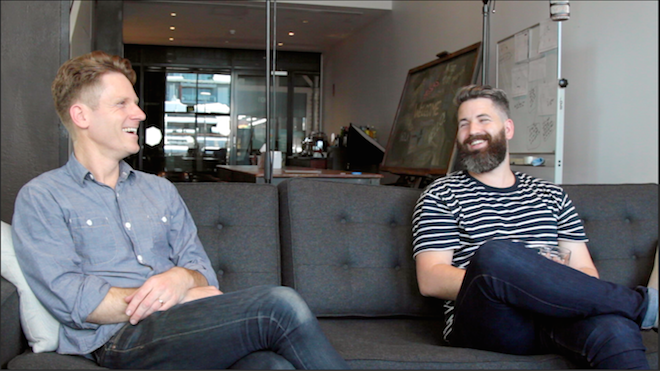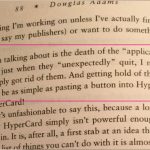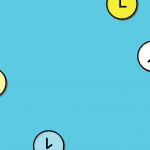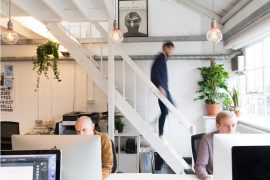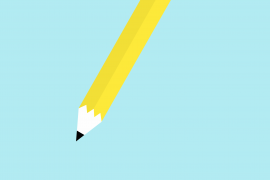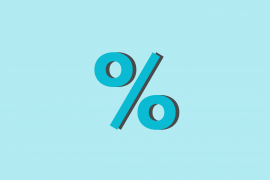
Streamtime caught up with Sons & Co. Founders Matt Arnold and Tim Kelleher to discuss awards, not having a website and why they like to keep it simple.
Like this podcast? You can find other insightful episodes on iTunes or at itsabouttime.simplecast.fm
Alternatively, if you’d prefer to read Sons & Co’s insights, here is an edited transcript of our conversation.
Starting out
Kye: What made you decide to partner up and start your own business?
Tim: I think me and Matt just got on really well and we worked in similar backgrounds within the web, which was kind of at an early stage. And we just kind of got on quite well as friends. And then we’d been doing a few projects together there, and we just thought well maybe we can just go out on our own I guess.
Matt: Yeah, and in fact the owner of the studio where we were working at the time, Phillip, was really encouraging and supportive, and that gave us confidence to go and do it.
Kye: Was it different to how you thought it would be ?
Matt: Well, we’d been working for quite a long time before we started our own studio. We both had 10 years in agencies or studios, and we were quite confident in our ability to do the work. We didn’t know anything about running our own business, but we knew as long as we could get work we’d be okay. But of course that’s not as easy as you might think, so really for the first year we kind of sat around drinking coffee, waiting for the phone to ring and surviving on bits and pieces. We would do anything really.
“For the first year we kind of sat around drinking coffee, waiting for the phone to ring.”
Tim: And we used to take like crazy long morning tea breaks and stuff, like we’d head down to the cafe and be there like 10 to 11…and we’re like, “Oh yeah, we’re flat out.” But yeah, it was just kind of adding that business component I guess on top of doing the work, right?
Matt: And nothing’s really changed. We haven’t become any better at it, we’ve just got a little bit more work. And it’s funny now looking back, if we had a job we’d think, “Gee this is great, we’re doing really well.” We thought we were quite busy whereas now we’re juggling lots of stuff. So, I think we had the confidence and we kept it quite small so it’s really been easy to manage. So there hasn’t been any large surprises. The big difference being that when we started we just had nothing to do.
No website required
Kye: Your website just has some contact details and that’s it. Was that a conscious decision?
Matt: Well the website, or the lack of website, initially was really through necessity because we didn’t have a portfolio of work. And we weren’t comfortable using work from our previous jobs, even though we had some nice projects, it didn’t feel right to put that under the Sons & Co banner. So we literally had nothing, the portfolio was empty. And because of that the website was purely contact details. And after a while, because we were getting a little bit of work coming in, we sort of liked that contrary idea of website designers who don’t have a website. And now we’re kind of stuck with it I think.
“We sort of liked that contrary idea of website designers who don’t have a website.”
But also it sort of fits in with this philosophy that we have trying to keep things as simple as possible and getting by with the bare minimum. And we don’t have a logo and we don’t have any social media accounts, and we don’t have stationery, or cards, or anything that you would associate with a professional. And we really enjoy that because not having a website means we don’t have to maintain it, we don’t have to update it, and it actually just makes life a lot easier. We can get on with the business of making websites for other people.
Kye: So it was kind of like a happy accident?
Tim: Yeah, just something we didn’t think too much about, and just stuck with it since, there’s not a big story or a lot of thought behind it. It’s just happened.
Kye: I like that.
Matt: And also I should mention that there’s the graphic design studio in Auckland called Alt Group, who we admire enormously.
Kye: They have some stunning work.
Matt: Mate, those guys, they’re exceptional in everything that they do. They don’t have a website, and I don’t think they ever have in the time that we’ve known them. They seem busy, they seem to be able to attract and do good work, so we also gain a little confidence from them too.
“It fits in with this philosophy that we have, trying to keep things as simple as possible and getting by with the bare minimum.”
It’s all in the family
Kye: So how did you get those first clients then?
Matt: Tim’s dad’s mate, a cousin, a friend of a friend, in the same way that everyone gets their first jobs.
Tim: And that hasn’t changed too much really.
Kye: So is it more a word of mouth kind of thing?
Matt: Very much so. Which is great because not having the website is actually kind of a positive thing, because all the work comes in by referral so the clients are qualified in some way, they know something about us, or at least they know someone who really recommends us. So they come in qualified, as opposed to a person who simply has the ability to use Google and search for a website designer. So that really, really helps. There’s a lot less time spent in meetings, and generally when someone arrives on the doorstep they’re ready to roll.
Our first ever job was for a venue called Black Estate, we just happened to be friends. And Tim, when we first started, had this really lovely idea that has been quite successful for us. He said, “If you want to work with people you have just got to start hanging out with them.” And we really love design and through our passion for design, so not just graphic design, but architectural, and furniture, and fashion, and every aspect of the industry, we’re all over it. So through that enjoyment we’ve met a lot of people, we befriended them, and in turn worked with them.
“If you want to work with people you have just got to start hanging out with them.”
Keeping it small
Kye: So you mentioned also that you keep the team small…
Matt: Yeah. Four people.
Kye: So with just four people, how do you work as a team? How do you get the optimisation out of four people with all that work?
Tim: I guess everyone’s got really defined roles, so everyone knows what they’re doing and there’s not a whole lot of talk in the studio. It’s just like, “Hey, we all know our jobs, we just got to get on and do the work.” And we have thought if we were to expand or grow how would you do it? And I think if we grow, then we probably wouldn’t be the doing the work, we’d turn into managers and looking out for people and stuff like that. So for now we really like the work and just the doing of it.
“I think if we grow, then we probably wouldn’t be the doing the work, we’d turn into managers.”
Matt: It just makes things really simple, and that’s a huge motivation for staying the size that we are when we’ve been four people pretty much six months from when we’ve started. It was just Tim and I initially, it just means, like Tim said, that we can focus on doing the work. Everyone knows exactly what they’ve got to do. We all sit together, so we don’t have to have independent meetings because everyone’s aware of what’s going on, even on projects that they’re not working on. And it just keeps things really, really straightforward.
Kye: And has it been the same four from that first six months?
Matt: No, well Matt, the other Matt not me, left and started working with some really great guys in Auckland called Assembly, in January.
Kye: Okay, that’s still such a long time.
Matt: Yeah it was, like five or six years we worked together. And then recently, well about 12 months ago, another friend Paul Bright, who’s a former lawyer and management consultant with Deloitte, studied computer science and law at Canterbury, he’s got back into software and he’s working with us now. So we were three briefly but back to full strength.
Kye: Wow that’s quite nice. In this industry, unless you are the business owners, people tend to move on at quite regular intervals. But to have people stay for that period of time must be quite nice.
Matt: I always think that says something about the company. When I started working in advertising, it was almost a badge of honor to have worked at double figure agencies, and even better if you had been sacked. Even if you’d been sacked numerous times, that kind of meant you were really great and obstinate. But I think it’s lovely when, regardless of what the business is, like your local cafe, you go back and it’s a familiar face. That’s really nice, and a high turnover staff can be quite disconcerting. So it’s good for our clients too and it’s great for us because we’re good friends. We know each other backwards and that just makes the whole process much easier.
“It was almost a badge of honor to have worked at double figure agencies, and even better if you had been sacked.”
Kye: Do the clients deal with you all, or do they funnel through you Matt? Tim’s like “I don’t talk to the clients.”
Tim: Yeah, I don’t talk for a month.
Matt: If it ever rings, I answer the phone and I read the emails, and make sure we have enough fax paper and whatnot.
Kye: Did you just say fax?
Matt: We don’t have a fax. And that was an arrangement that Tim and I agreed to right at the very beginning. He said, “Hey look, you’re going to have to talk to clients because I hate being told what to do.”
Kye: Is that true?
Tim: Yeah. You know I think it’s really good to just kind of focus on the work, and Matt’s really good, just that filter’s really nice.
Matt: We’re always together when we’re at important points in the project with the client, I think that’s fine.
Tim: And we sit at the same desk and I can hear him talking to everyone and we’re talking all the time, so there’s not a divide between us.
Kye: There’s no lost in translation.
“You’re going to have to talk to clients because I hate being told what to do.”
Matt: I think that’s really important, you got to hear it. I was reading, it was ages ago and it was from Frost and did a little article about the importance of designers being in the room with clients, especially at those critical points, the briefing, creative presentations, and feedback and whatnot. I just think there’s no substitute for hearing it direct. And you’re right, things do get lost in translation. But I think with Tim and I, we’re so aligned and so like-minded, and there’s a trust and if he’s not there or I’m not there, then it’s not really an issue.
It just makes it a bit easier if there’s a single point of contact most of the time. But anyway, all our clients know there’s only four guys, so at some point or another the client’s spoken to all of us.
The NZ factor
Kye: You guys are based in Christchurch, but you don’t just have clients in Christchurch, you don’t just have clients in New Zealand, you’ve got clients internationally. Is it difficult being that far away or you haven’t found it a problem?
Tim: I guess six years ago I always thought it used to be probably more challenging, where people weren’t always on email and Skype and all that. But now everyone’s so used to it, you don’t find a client who’s not used to working that way, so that’s been really good.
Kye: Do you travel much?
Matt: Surprisingly not. Probably most people have not been to Christchurch, many would not even know anything about it. We’re on the south island of New Zealand, it’s a small city and we live there. It’s really beautiful, the quality of life’s great. I grew up in Sydney and worked in Melbourne for many years, so I’ve got some point of perspective. We really enjoy it down there so we have this really nice life, we’ve both got families, and it’s all really relaxed, and we’re riding our bikes around to get to and from work. It’s a lovely place to live, but I think if we were forced to work exclusively in Christchurch, we’d probably creatively shrivel up and die. And we’ve been really fortunate in attracting work, as you said, not just from other places in New Zealand, but from Australia and internationally.
“We’ve been really fortunate in attracting work, not just from other places in New Zealand, but from Australia and internationally.”
I think maybe because of the type of work we’re doing, because it is web based, we feel more comfortable with web based communication. It’s not such a big thing and we’ve got some good buddies in Wellington, Resn, who are just a killer digital agency. Probably far better known internationally than they are within New Zealand. And I was talking to one of the guys there, Johnathan once, they work primarily with international clients, mostly ad agencies. They set up an office in Amsterdam and he said, “You know it’s funny because a lot of the European clients prefer to continue to work with guys in Wellington, because they really loved the idea of these guys being like way out there geographically, as well as creatively.” So there was some appeal in working with New Zealanders. There’s a slightly exotic aspect to it.
Kye: I think even more so than Australian, particularly at the big agency level, I think a lot of good stuff comes out of New Zealand. And I often wonder if it’s because you’re not so constrained there. Or maybe you just have better talent over there.
Matt: Well it’s in our best interest to agree with you. New Zealanders are amazing.
Awards are good for business
Kye: At the recent Best Awards in New Zealand you guys received the Interactive Purple Pin, four Gold, two Silver, two Bronze and five finalists. Congratulations. And then the reason you’re in Sydney, sadly wasn’t just to because I asked you guys to be here, you’re here for the AGDA Awards tomorrow night. Are awards important to you? Because you seem to win a lot of them and is it important to enter them and to be recognised by those peers?
Matt: It’s a pretty divisive topic isn’t it in this industry?
“We think they’re wonderful because we really believe in this idea of a design community.”
Kye: I know, but that’s okay. You’re in a safe place.
Matt: Yeah, well you kind of got a camp that thinks awards are good and a positive thing for the industry, and good for design. And then the other side who thinks that it’s complete masturbation.
We’re in the former camp. And well there’s nothing wrong with masturbation anyway. But I think for us, and we’re quite involved within the New Zealand Best Design Awards put on by The Designer’s Institute, and we’re reasonably involved. Tim’s judged and I’m on the board of The Designer’s Institute and we enter a lot. But we think they’re wonderful because we really believe in this idea of a design community. I think design is a social vocation, you ultimately have to work with other people, and that’s part of the reason why we’re in it and what makes it so fun. So we really like this idea of the design community, and for this thing to exist it has to be visible. And you need to give people ways in which they can participate, and awards is just one of those ways.
But I think it’s really important also as an archive design, because a lot of this work would never be seen otherwise because it gets done, it’s done and it kind of filters out there but mostly it pretty invisible, unless it’s really large scale corporate work. So I think the awards not only celebrate the really original, experimental work, and that’s really important, but it also it is that archive and index of a country’s graphic design output.
Kye: And I take it you guys get some work through your recognition of awards?
“I think the awards not only celebrate the really original, experimental work, and that’s really important, but also it is that archive and index of a country’s graphic design output.”
Tim: Yeah, I guess that’s where you can see a lot of our work is on the Best Awards website and things like that. And just being in Christchurch that really helps get our work out there, and socially we really like going out to the awards and other events, so just kind of getting out there. But yeah, we definitely do find it helps to attract work.
Matt: It’s great marketing. In fact, when the Best Awards finalists were announced and went up on the website this year we had a call that day from a wonderful company, they were a dream job. It’s like, “We just saw you, you guys had heaps of stuff in there, do you want to work with us?” So it definitely has helped us, and we really enjoy winning them, we really enjoy that peer recognition, we love going to the events because they’re really social and being in Christchurch we’re really isolated physically from the design community. So it’s wonderful to go up to Auckland every year and wonderful to come over to Australia and talk to all these people who we really admire and whose work we really love and feel kind of connected. And like you said, it’s good for business.
Kye: Tim, you’ve been involved in judging awards, over the years have you seen the standards change or are you always surprised about what gets submitted? What kind of things do you look for?
“We really enjoy winning them, we really enjoy that peer recognition, we love going to the events because they’re really social.”
Tim: Yeah, I don’t know, I guess it’s always quite interesting to see like in a year and how much good work there is, and everyone’s kind of chipping away and it’s just like “Whoa,” each year, and it’s the usual suspects as well. There’s Resn, and there’s consistent players, but then there’s always going to be a few surprise projects kind of popping out that you probably didn’t see within that year.
Who inspires you?
Kye: Who does inspire you guys? What’s your inspiration on a daily basis to come in and do that good work?
Matt: Well, golly, there’s so many amazing people. I mean in Sydney, to keep the discussion local, Toko, Michael and Ava. Danielle and Paul at Garbett are so good, Chris Doyle, Mark Gowing, I mean these are all people whose work is just exceptional and who we’ve also met and are such nice people.
Tim: Yeah, and we got to work with Paul and Danielle at Garbett on their site at the start of this year and that was a bit nerve wracking kind of designing a graphic designer’s website. At the end of it we became really good friends, and it was really good and it was really positive. It was just kind of cool knowing that they’re doing really great work and they came to us and then we worked as a team.
Kye: What about people you haven’t met that have been an inspiration, that may have made you come into the creative industry?
Matt: That’s a good question. Well my design hero is Glenn Murcutt, the Australian architect, both because I love his buildings, but also I love the way in which he works. He is essentially a sole practitioner and always has been. He really just does houses, very modest lightweight houses. I don’t think he’s ever done a large civic building, or a museum or anything like that. As far as I know he’s never done a building outside of Australia. In fact I don’t think he would. And he’s won the Pritzker Prize, the biggest architecture prize there is, and he’s still going strong, still producing absolutely stunning buildings. He gives an enormous amount of time to teaching, you know he just seems like the perfect designer.
“My design hero is Glenn Murcutt, both because I love his buildings, but also I love the way in which he works.”
Kye: What about you Tim?
Tim: The question reminded me of this little thing we do each year. We find someone to design us a t-shirt for our clients and we only do 100. I don’t know who was the first one that we did, was it…?
Matt: The International Office.
Tim: Yeah, at the time we didn’t know Duncan and Elena, and we just emailed them and said, “Hey would you design us a t-shirt?” And they were like, “Yeah sure,” There was no brief, I think it was based on the next year, but it was all pretty chilled. And then the year after that we emailed Wim Crouwel just randomly because he’s just sitting there, right…
Kye: Did he reply?
Tim: Yeah, so he did one. He was just straight on the email and sends us a PDF like a month later. So every year we’ve been working with a different kind of design hero of ours.
Kye: You guys tried to contact Peter Saville once didn’t you?
Matt: We did, yeah. You called him on the phone didn’t you?
Tim: Yeah.
Kye: You actually got to speak to him?
Tim: No I didn’t get to talk to him I got to talk to his secretary.
Kye: Oh man, that would be one of my design heroes only because I was well into the music that came out of Factory Records, but also I think he changed the way the music industry looked at design.
Matt: Graphic design, as far as pop and rock music has been a really huge part of the music scene, with album covers especially. The first Joy Division album cover with the pulse radio waves…it’s one of the most famous pieces of graphic design. And we had the chat about the job he did for the fashion label Lacoste, they’re really famous for their polo shirts with the alligator logo on them.
“He completely ignored the brief and got a great result that Lacoste really loved.”
And I think they came to him with a brief that said to design a shirt. They said, “You can do whatever you want but you can’t touch the logo.” And all he did was mess with the logo, and I think he digitised it and then ran the logo through a bunch of different filters, and just fucked it up really. And came out with 80 different versions of the alligator, and some were quite funny and others were really almost indiscernible. And it was a really nice thing I thought, because he completely ignored the brief and got a great result that Lacoste really loved. And those shirts are collectors’ items. Peter Saville is a remarkable designer, and there’s no comparison between us and him. However, that process I find really interesting, sort of something that Bob Gill, the American graphic designer, who was a founder of Pentagram, would do. He’s designing our t-shirt this year.
He’s done it and he sort of had this idea about design, and briefs and clients, and essentially designers are problem solvers and the client comes with a question and our job is to answer it. And Bob Gill had this idea was that the question the client is asking is not always the right question, and within the brief you’ve got to find the right question to answer. Designers get criticised often for providing the wrong answer, but I think it’s equally true that the clients can ask the wrong questions.
And that little Lacoste story to me is a wonderful illustration of finding the right question to answer within the brief, and it actually wasn’t the one that the client was asking. It’s a fine line, I mean you’ve got to be good, because otherwise you’re just being kind of disobedient and difficult. But if you do get it right, it’s a wonderful moment where everyone thinks, “Yeah, damn that’s what we’re looking for.”
“It’s a wonderful illustration of finding the right question to answer within the brief, and it actually wasn’t the one that the client was asking.”
Best piece of advice
Kye: What’s the best piece of advice you’ve ever been given?
Matt: In Christchurch we’re recently really fortunate because a big Martin Creed work was installed. An English artist, I guess he was one of the young British artists, in fact none of the young British artists are young anymore, but his work is really fantastic. Conceptually it’s all over the place, but all equally good. An amazing man bought this artwork for the city and it’s installed on the side of the Christchurch Art Gallery. It’s a big neon sign that just says “Everything is going to be alright.” And I think this kind of ties in with what you’re saying, it’s not a piece of advice as such, but I kind of like the positive nature. Don’t worry, it’ll be cool.
Advice for future designers
Kye: Any advice you’d like to give to young designers coming up through the ranks?
Matt: When we started out, we went around to a bunch of people who we trusted and admired and tried to get advice. And a lot of those guys who we really respected said, “Don’t take my advice, because it’s really irrelevant to you because I can only speak for my own situation.” And I sort of liked that sentiment, the really, really smart guys weren’t really too pushy with their philosophies on things, they’re like, “you’ll find your own voice.”
I was really fortunate to work with Emery Studio in Melbourne. Garry Emery is a really wonderful designer, kind of the godfather of modern graphic design in Australia I think. And I was sitting in a meeting once and a designer and client were arguing over something, and it was getting quite heated and he sort of stepped in and said, “It actually doesn’t it matter? We’ll change it, it’s fine because the thing that you’re arguing about is not important.” And I think that takes time and experience to be able to identify, in a design what matters and what doesn’t. But that kind of perspective I think is really, really important because you can get really bogged down and fight for things that aren’t actually important. Conversely, things that are of real value can get dropped easily too if people don’t focus on the right things. So that was a really wonderful thing to learn, that perspective.
“Let’s just take no advice and just figure it out on our own.”
Tim: I think when we started out we were kind of looking for the advice from other people and there’s so much and it’s quite conflicting. We kind of almost said like, “Let’s just take no advice and just figure it out on our own,” in a way, right?
Matt: Yeah, and for that reason we shy away from giving advice. But I am exceptionally impressed with design students and graduates who know their design history, and equally it can be quite bewildering when you come across a student who’s enthusiastic about the job, but is not aware of where design came from, and the important figures, and styles, and moments in design and, I’m always really thrilled when you find that young kid who’s really on top of that stuff.
Tim: And also where they want to be. We say, “Hey, what’s your dream job?” And they’re like, “Well I don’t know.” It could be just design in general, but when someone says I want to be in a small studio at X. But yeah we talk to heaps of students who are just like, “Oh, I don’t know. I haven’t really thought that through.”
Matt: And the other thing is you can just contact studios, it’s really easy and everyone’s really friendly. At least they are in New Zealand. You call Inhouse or Alt, or us or whomever, all of the good guys, the creative director picks up the phone and says, “Hello,” and is happy to chat and happy for anyone to go in and have a beer, it’s really wonderful. So young designers shouldn’t be shy in that regard. Especially the good guys who are really, really lovely from our experience.
The future
Kye: When you guys started Sons and Co back in 2008 you wanted to create the kind of company that you knew you’d still be running when you were old, is that still the case after seven years?
“We want to do this until we stop working, and that’s a really lovely feeling.”
Matt: Yeah, very much so. I mean we want to do this until we stop working, and that’s a really lovely feeling. And the other thing that I really enjoy, which is kind of the opposite of what a lot of people advise, is that we’re heavily, heavily dependent upon each other. If one of the four leaves we’re in a bit of strife. And if you’re giving business advice you’d probably say, “Well make sure that all the team members can easily be replaced,” and we’re at the opposite end of the spectrum where we’re stuffed. If Tim goes it’s over, and that creates quite a bond. I really, really enjoy that and it’s fraught with risk, but I think from that comes a reward. But definitely, this is it for us.
Tim: Yeah, and it’s nice that I’m not sitting there and I don’t think Matt is either, thinking, “Oh it would be really good if we could work anywhere else.” We’re not sitting there going, “Oh I wish I could get a job at X studio or…” So it’s quite nice just saying, “Well it’s up to us on the work we produce,” and we’re happy within ourselves, we just got to keep doing it.
Matt: Yeah, if either of us want to work in a better studio then it’s up to us to improve our own studio.
Kye: Well thank you so much for taking the time and good luck tomorrow night at the AGDA Awards.
The day after this podcast was recorded Sons & Co. continued their winning streak picking up six Distinctions and four Finalists at the AGDA Awards. You can view their award winning work here.


